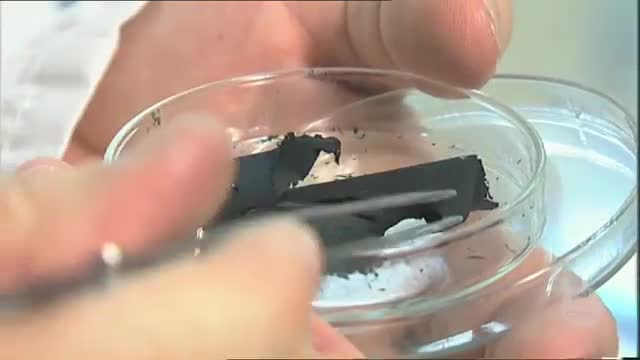Premium Only Content

Spinning carbon nanotubes (2005)
Spinning carbon nanotubes (2005)
from the wayback machine (They are trying to hide this information)
Avantex Innovation Prize for carbon nanotube team
Research into carbon nanotubes —
sub-microscopic fibres of pure carbon — has demonstrated that they can be spun into stable yarns thereby offering the prospect of producing textiles made exclusively of carbon nanotube yarns with a wide range of new applications.
from the wayback machine (They are trying to hide this information)
https://web.archive.org/web/20161229191907/https://www.csiro.au/news/transcripts/YouTubeTranscripts/Archives/Spinning_carbon_nanotubes.html
Transcript
Music plays and text appears: Spinning Carbon Nanotubes]
[New text appears: Innovation prize avantex 2005 for New Materials]
Narrator: Carbon nanotubes are one of the most promising new materials in textile science.
[Image has changed to show two scientists reviewing microscopic images of carbon nanotubes]
They are sub-microscopic, hollow fibres of pure carbon, which look like black powder but their true fibre nature becomes apparent under the electron microscope. They are light but incredibly strong, and the challenge has been to find a way to harness that strength.
[Camera zooms in on a scientist completing an experiment with nanotubes]
The tubes can be mixed with polymers, but one of the problems with the resulting composites is that the polymers destroy the nanotubes electrical conductivity.
[The University of Texas Nano Tech Institute logo appears on screen]
But now CSIRO's Division of Textile and Fibre Technology, in collaboration with the Nano Tech Institute at the University of Texas at Dallas, has made a major breakthrough.
[Image changes to show a picture of the carbon nanotube yarn]
A 100% carbon nanotube yarn. This yarn is very strong, durable and flexible and fully retains the electrical properties of carbon nanotubes.
[Image changes to show Dr Stephen Hawkins, CSIRO Textile & Fibre Technology]
Dr Stephen Hawkins: We're able to take the nanotubes directly from the substrates, spin them into yarn, twist that yarn onto a bobbin and there after use the yarn as one would a conventional textile.
[Image changes to show Dr Hawkins working in a laboratory]
Narrator: The first part of the process is an improvement in the growing of carbon nanotubes in the laboratory.
[Image has changed to Dr Hawkins showing samples of the carbon nanotubes using tweezers and picking them, up from a petri dish]
Dr Stephen Hawkins: Carbon nanotubes are typically 1 to 100 nanometres in diameter. Ours are in the range of 10 to 50 nanometres in diameter and we have made them up to three millimetres in length. Although typically one millimetre is the length we aim for.
Narrator: Then the problem is in capturing those tubes into a yarn.
[Camera zooms in on the prototype spinner]
This is the prototype spinner being trialled at the Nano Tech Institute at the University of Texas in Dallas, which has allowed CSIRO's Division of Textile and Fibre Technology to spin the carbon nanotubes into a yarn.
[Image has changed back to pictures of the carbon nanotube yarn]
Ken Atkinson: The big breakthrough that's happened in the last year with carbon nanotubes is the discovery that you can use twist to bind them together into a macro structure that is hundreds of thousands of nano tubes.
Dr Stephen Hawkins: The yarn as a single twisted structure is only three microns in diameter.
[Image has changed back to Dr Hawkins]
For comparison a wool fibre, a single wool fibre, is usually in the vicinity of 20 microns in diameter.
So we are producing a yarn that has many thousands of carbon nanotubes in its cross section, that is only one sixth of the diameter of a single wool fibre.
Such a fibre is almost impossible to see with the naked eye, for example, so that is a challenge in simply handling and processing this material.
Narrator: These single yarns can then be made into various plies or thicknesses and in the future, woven into fabric.
[Image changes to show people walking through city streets and then to a group of cyclists riding]
The result could mean products such as smart clothing with the ability to determine body temperature and adjust accordingly, or even act as a power source.
[Image has changed to show Ken Atkinson, CSIRO Textile & Fibre Technology]
Ken Atkinson: The other use is to use the yarns as actuators. With actuators as muscle replacements you can have, you can provide drives for people who have disabilities. These actuators would be electrically operated to move arms, move legs.
[Image changes to show pictures of each of what the narrator describes below flashing by on the screen]
Narrator: Other major potential uses are in medicine, fire fighting and in the defence forces. This material could be invaluable to the aerospace industry.
Ken Atkinson: What aeronautical engineers want from a yarn is high specific strength, that is high strength and low weight.
[Image has changed back to Ken Atkinson]
So on the battlefield, the American military would like robotic soldiers and pneumatic and hydraulic systems are not suitable for this application.
Potentially they have a use for emergency services, say in fire protection services where you want to send a robot into a building to rescue people.
[Image changes to show the Science magazine being opened to an article titled Multifunctional Carbon Nanotube Yarns by Downsizing an Ancient Technology Mei Zhang, Ken R. Atkinson, Ray H. Baughman]
The project's now at the stage where we have a patent for, that has over 200 claims.
[Image has changed back to Ken Atkinson]
Carbon nanotube yarns are very exciting. They have tremendous properties and there is an opportunity for potential licensees to adopt the technology to take it to the next stage of development.
[Music plays and CSIRO logo appears on screen]
-
 9:18
9:18
Watchman's Duty
16 days agoBuilding with Cob - A Natural & Affordable Way to Build a House
1.28K3 -
 0:02
0:02
MellyHatchet
3 years agoFire Spinning
40 -
 0:46
0:46
Children's Toy Channel
3 years agoSnoopy Spinning Toy
40 -
 0:57
0:57
NickyGlanma
4 years agoSpinning prf diy
279 -
 1:03:37
1:03:37
The Rubin Report
3 hours agoMedia Caught Trying to Ignore Ugly New Details of Charlotte Train Stabbing Caught on Tape
36K57 -
 LIVE
LIVE
Rebel News
1 hour agoConservative MP rips Doug Ford, Carney's decarbonization scheme, Security cam rules | Rebel Roundup
266 watching -
 58:13
58:13
Badlands Media
2 hours agoThe Daily Herold: Sept. 8, 2025
8.19K1 -
 LIVE
LIVE
LFA TV
15 hours agoLFA TV ALL DAY STREAM - MONDAY 9/8/25
3,301 watching -
 1:39:10
1:39:10
Nikko Ortiz
3 hours agoDont Be A Chicken Turns Into Fails...
25.2K1 -
 1:44:56
1:44:56
The Mel K Show
2 hours agoMORNINGS WITH MEL K -Won’t Be Fooled Again? America Must Know the Hidden Truth About Post WWII Globalization 9-8-25
17.6K5